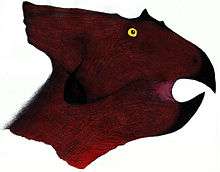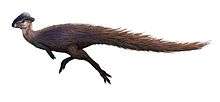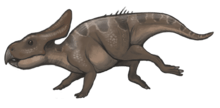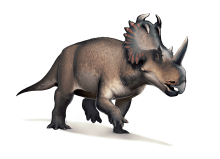Breviceratops
| Breviceratops | |
|---|---|
 | |
| Head reconstruction of Breviceratops | |
| Scientific classification | |
| Kingdom: | Animalia |
| Phylum: | Chordata |
| Clade: | Dinosauria |
| Order: | †Ornithischia |
| Family: | †Bagaceratopidae |
| Genus: | †Breviceratops Kurzanov, 1990 |
| Species: | †B. kozlowskii |
| Binomial name | |
| Breviceratops kozlowskii Maryańska & Osmólska, 1975 | |
Breviceratops (meaning "short horn face") was a herbivorous ceratopsian dinosaur from the Late Cretaceous of Mongolia.
Discovery and naming
The first fossils were during the 1960s discovered by the Polish expedition to the Khulsan locality in the Nemegt Basin, Gobi Desert. The specimens were originally described by Teresa Maryańska and Halszka Osmólska in 1975 and named as a second species of Protoceratops, Protoceratops kozlowskii, the specific name honouring Polish paleontologist Roman Kozłowski.[1]
The holotype, ZPAL MgD-I/117, was found in the Barun Goyot Formation dating from the late Campanian. It consists of a juvenile postcranial skeleton. Other specimens were referred: MgD-Ij116, a skull and lower jaws of a juvenile; MgD-Ij 118, fragmentary postcrania and lower jaws of a juvenile; MgD-Ij119, a dentary and three neural arches; MgD-IjI20, two dentaries and loose teeth; MgD-JjI21, a maxilla fragment with four teeth of a juvenile; and MgD-JjI22, teeth.
They were then named as a separate genus, Breviceratops, by Sergei Mikhailovich Kurzanov in 1990, the generic name combining the Latin brevis, "short", with a reference to the Ceratopsia.[2] Kurzanov also referred an additional number of fossils from Khermin Tsav, the type locality of Bagaceratops, to the new genus. The Khermin Tsav specimens closely resemble Bagaceratops, which has led to the proposal that Breviceratops and Bagaceratops are synonymous. However, the type specimen from Khulsan has premaxillary teeth and lacks a foramen between the premaxilla and maxilla, features inconsistent with Bagaceratops.
Classification
Breviceratops belonged to the Ceratopsia, a group of herbivorous dinosaurs with parrot-like beaks which thrived in North America and Asia during the Cretaceous Period. It has been assigned to the Bagaceratopsidae by Vladimir Alifanov,[3] in which Magnirostris appears to be its closest relative.[4]
See also
References
- ↑ Maryańska, T.; Osmólska, H., 1975, "Protoceratopsidae (Dinosauria) of Asia", Palaeontologica Polonica 33: 133–181
- ↑ Kurzanov, S., 1990, "A new Late Cretaceous protoceratopsid genus from Mongolia", Palaeontological Journal, 24: 85-91
- ↑ Alifanov, Vladimir (2003). "Two new dinosaurs of the Infraorder Neoceratopsia (Ornithischia) from the Upper Cretaceous of the Nemegt Depression, Mongolian People's Republic". Paleontological Journal. 37 (5): 524–535.
- ↑ Alifanov, V.R. (2008). "The tiny horned dinosaur Gobiceratops minutus gen. et sp. nov (Bagaceratopidae, Neoceratopsia) from the Upper Cretaceous of Mongolia". Paleontological Journal. 42 (6): 621–633. doi:10.1134/S0031030108060087.


